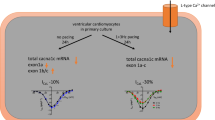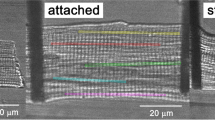Abstract
A major limitation in long-term studies of quiescent adult cadiomyocytes in culture has been the decline in contractile properties of the cells over time. Regular contracting cardiomyocyte cultures may represent a more physiological model. The aim of the present study was to investigate the mechanical properties and calcium handling of myocytes after 24 hours of electrical stimulation at 1 Hz. In a random and blind design, stimulated (S) and unstimulated (U) myocytes were examined using an inverted microscope which allows continuous length recordings and measurements of intracellular Ca2+. Fractional shortening examined at 0.25 Hz was 14.67±0.51 % in S cells and was not significantly different from U cells. However, at higher frequencies we found a significant difference in mechanical properties between the two groups. At 2 Hz fractional shortening was 12.03±0.67 % in S cells, but only 8.07±0.94 % U cells (P<0.05). We were able to abolish the difference between the two groups by stimulating with the β-adrenergic agonist isoproterenol. Measurements of Ca2+ transients were made at 1 Hz after loading with fura 2-AM. Peak fura 2 ratio was 25.4% greater in S cell compared to U cells. Resting fura ratios were not significantly different. Caffeine-induced transients were greater in S than in U cells. [3H]-ryanodine-binding and Ca2+-ATPase contents were not significantly different. In conclusion, we have found that regular electrical stimulation of adult ventricular myocytes in culture, so that they contract rhythmically, enhances both mechanical properties and calcium transients when compared to quiescent myocytes. These results suggest that regular electrical stimulation is important when studying the function of adult ventricular myocytes in culture.
Similar content being viewed by others
References
Berger HJ, Prasad SK, Davidoff AJ, Pimental D, Ellingsen O, Marsh JD Kelly RA (1994) Continual electric field stimulation preserves contractile function of adult ventricular myocytes in primary culture. Am J Physiol 266: H341-H349
Bouchard RA, Clark RB, Giles WR (1995) Effects of action potential duration on excitation-contraction coupling in rat ventricular myocytes. Action potential voltage-clamp measurements. Circ Res 76: 790–801
Boyett MR, Frampton JE, Harrison SM et al., Noble MIM, Seed WA (eds) (1992) The Interval-Force Relationship of the Heart. Cambridge University Press. New York. The role of intracellular calcium, sodium and pH in ratedependent changes of cardiac contractile force. p 111–72
Bradford MM (1976) A rapid and sensitive method for the quantitation of microgram quantities of protein utilizing the principle of protein-dye binding. Anal Biochem 72: 248–254
Capogrossi MC, Kort AA, Spurgeon HA, Lakatta EG (1986) Single adult rabbit and rat cardiac myocytes retain the Ca2+- and species-dependent systolic and diastolic contractile properties of intact muscle. J Gen Physiol 88: 589–613
Dubus I, Rappaport L, Barrieux A, Lompre AM, Schwartz K, Samuel JL (1993) Contractile protein gene expression in serum-free cultured adult rat cardiac myocytes. Pflugers Arch 423 (5–6): 455–461
Ellingsen O, Davidoff AJ, Prasad SK, Berger HJ, Springhorn JP, Marsh JD, Kelly RA, Smith TW (1993) Adult rat ventricular myocytes cultured in defined medium: phenotype and electromechanical function. Am J Physiol 265: H747-H754
Everts ME, Andersen JP, Clausen T, Hansen O (1989) Quantitative determination of Ca2+-dependent Mg2+-ATPase from sarcoplasmic reticulum in muscle biopsies. Biochem J 260 (2): 443–448
Holt E, Christensen G (1997) Transient Ca2+ overload alters Ca2+ handling in rat cardiomyocytes: effects on shortening and relaxation. Am J Physiol 273: H573-H582
Ivester CT, Kent RL, Tagawa H, Tsutsui H, Imamura T, Cooper G (1993) Electrically stimulated contraction accelerates protein synthesis rates in adult feline cardiocytes. Am J Physiol 265: H666-H674
Janiak R, Lewartowski B, Langer GA (1996) Functional coupling between sarcoplasmic reticulum and Na/Ca exchange in single myocytes of guineapig and rat heart. J Mol Cell Cardiol 28 (2): 253–264
Kato S, Ivester CT, Cooper G, Zile MR, McDermott PJ (1995) Growth effects of electrically stimulated contraction on adult feline cardiocytes in primary culture. Am J Physiol 268: H2495-H2504
Komuro I, Kaida T, Shibazaki Y, Kurabayashi M, Katoh Y, Hoh E, Takaku F, Yazaki Y (1990) Stretching cardiac myocytes stimulates protooncogene expression. J Biol Chem 265 (7): 3595–3598
Lipp P, Huser J, Pott L, Niggli E (1996) Spatially non-uniform Ca2+ signals induced by the reduction of transverse tubules in citrate-loaded guinea-pig ventricular myocytes in culture. J Physiol (Lond) 497 (3): 589–597
Lowry OH, Passonneau JV (1972) A flexible system of enzymatic analysis. Academic Press, New York. A collection of metabolite assays. pp 146–218
Mitcheson JS, Hancox JC, Levi AJ (1996) Action potentials, ion channel currents and transverse tubule density in adult rabbit ventricular myocytes maintained for 6 days in cell culture. Pflugers Arch 431 (6): 814–827
Negretti N, O'Neill SC, Eisner DA (1993). The relative contributions of different intracellular and sarcolemmal systems to relaxation in rat ventricular myocytes. Cardiovasc Res 27 (10): 1826–1830
Pollack PS, Carson NL, Nuss HB, Marino TA, Houser SR (1991) Mechanical properties of adult feline ventricular myocytes in culture. Am J Physiol 260 (1 Pt 2): H234–41
Rousseau E, Meissner G (1989) Single cardiac sarcoplasmic reticulum Ca2+-release channel: activation by effeine. Am J Physiol 256: H328-H333
Schluter KD, Millar BC, McDermott BJ, Piper HM (1995) Regulation of protein synthesis and degradation in adult ventricular cardiomyocytes. [Review]. Am J Physiol 269: C1347-C1355
Shattock MJ, Bers DM (1989) Rat vs. rabbit ventricle: Ca flux and intracellular Na assessed by ion-selective microelectrodes. Am J Physiol 256: C813-C822
Takahashi T, Schunkert H, Isoyama S, Wei JY, Nadal-Ginard B, Grossmann W, Izumo S (1992) Age-related differences in the expression of proto-oncogene and contractile protein genes in reponse to pressure overload in the rat myocardium. J Clin Invest 89: 939–946
Tung L, Sliz N, Mulligan MR (1991 Influence of electrical axis of stimulation on excitation of cardiac muscle cells. Circ Res 69: 722–730
Wetzel GT, Klitzner TS (1996) Developmental cardiac electrophysiology recent advances in cellular physiology. [Review]. Cardiovasc Res 31 Spec No: E52–60
Author information
Authors and Affiliations
Corresponding author
Rights and permissions
About this article
Cite this article
Holt, E., Lunde, P.K., Sejersted, O.M. et al. Electrical stimulation of adult rat cardiomyocytes in culture improves contractile properties and is associated with altered calcium handling. Basic Res Cardiol 92, 289–298 (1997). https://doi.org/10.1007/BF00788941
Received:
Revised:
Accepted:
Issue Date:
DOI: https://doi.org/10.1007/BF00788941




